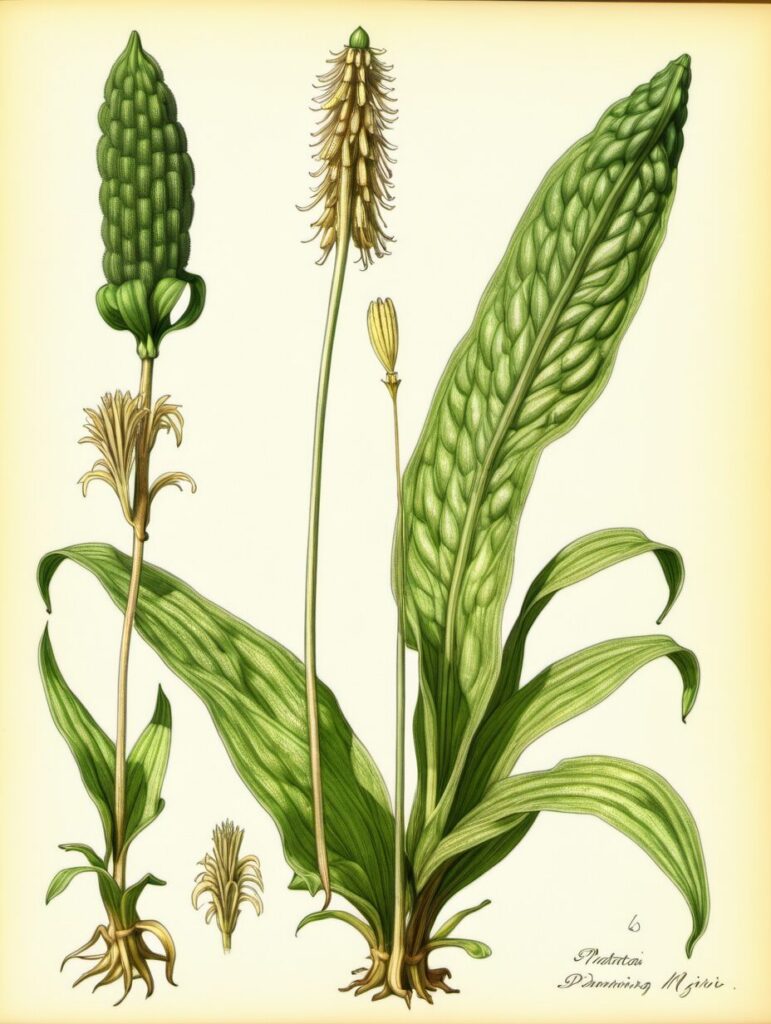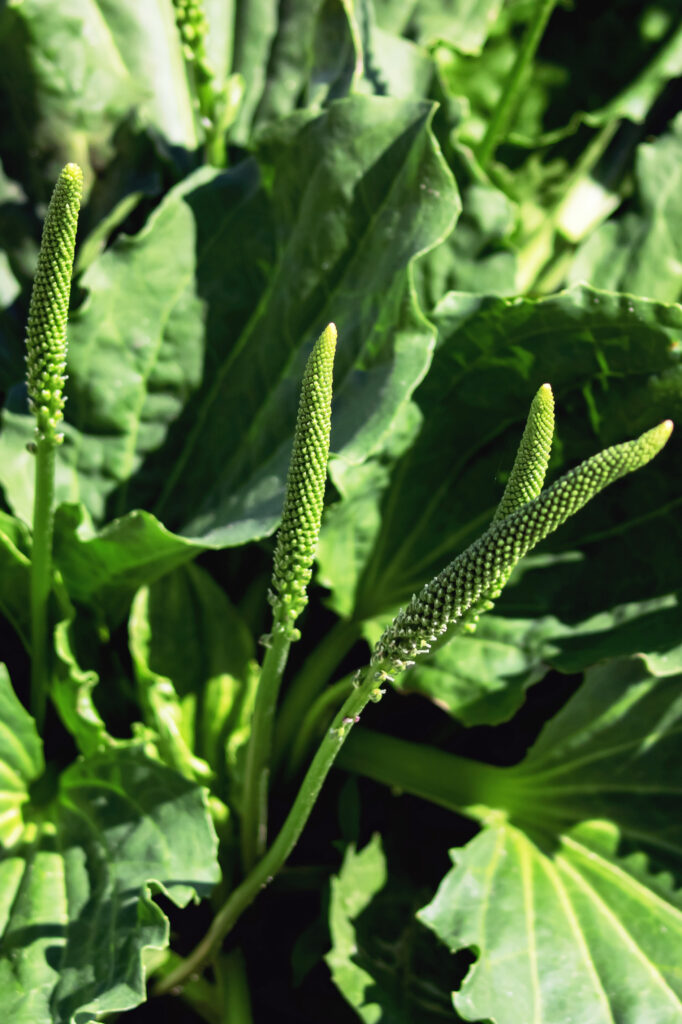Plantain, often seen as just a common weed, holds a remarkable position in the world of natural medicine. Known scientifically as Plantago, this perennial herb is easily identified by its broad, oval-shaped leaves that feature prominent parallel veins, growing in a basal rosette pattern. The leaves, smooth-textured and dark green, form a cluster at the plant’s base, and are complemented by tall stalks bearing clusters of greenish-white flowers. These spikes stand upright and mature into seed pods containing the plant’s seeds. The name Plantago is derived from the Latin “planta,” meaning foot sole, reflecting how the plant’s broad leaves resemble a foot sole. Moreover, its common name “White man’s foot” was coined by Native Americans, observing the plant’s spread along paths where Europeans walked, likely due to seeds sticking to muddy boots and horse hooves. Yet, beyond this narrative, North America houses over 35 Plantago species, a mix of native and introduced varieties.



Plantain is celebrated for its skin-soothing and healing properties. The leaves harbor anti-inflammatory and antimicrobial compounds that are beneficial in treating skin irritations, cuts, and insect bites. The mucilage in plantain leaves delivers protective and moisturizing effects, offering relief for dry, itchy skin conditions. A crucial biochemical found in plantain is aucubin, a compound playing a significant role in skin regeneration and wound healing. It reduces inflammation, prevents infections, and enhances collagen production, vital for skin’s structural integrity and elasticity. By stimulating collagen and supporting new skin cell growth, aucubin aids in closing wounds and improving overall skin health. Furthermore, aucubin’s antioxidant properties protect skin cells from oxidative stress, facilitating efficient healing. Traditionally used as a “spit poultice” (by chewing the leaves thoroughly), plantain provided folk remedies for snake bites, cuts, and various skin conditions over the ages.
Additionally, plantain supports respiratory health, easing coughs, congestion, and sore throats. Its expectorant nature assists in clearing mucus and soothing respiratory tract irritation. Culturally, plantain leaves have been used in lung support compounds, highlighting their versatility. The remarkable regenerative ability of plantain is evident as damaged leaves release chemicals promoting healing and providing infection protection. This self-healing trait contains allantoin, promoting cell proliferation, and aucubin acting as a natural antibiotic. Historically, plantain leaves, known as “the gunshot herb,” were used in wars to treat wounds, reflecting their reputation as a remedy for external injuries.
Plantain seeds, often referred to as psyllium, are rich in soluble fiber, forming a gel-like substance in the digestive tract, aiding in easing bowel movements, and relieving constipation. These seeds also soothe the digestive system, helping alleviate gastrointestinal issues such as diarrhea and irritable bowel syndrome. The fiber content also supports cholesterol-lowering properties by binding with cholesterol in the gut, improving heart health. Psyllium seeds similarly slow down glucose absorption, preventing blood sugar spikes post-meals, beneficial for diabetic individuals or those at risk. With proper water intake, psyllium husks become a popular natural remedy for promoting digestive health, heart health, and blood sugar management. They promote feelings of fullness, aiding weight management efforts, making them increasingly popular among health-conscious individuals.
Worldwide, plantain thrives even in harsh climates, resilient against tough conditions. Whether nestled in cracks of concrete or growing in open fields, this plant exhibits a tenacious ability to adapt and survive. Its resilience underlies its use in various traditional medicine systems. In the Ayurveda system, plantain is considered beneficial for balancing Pitta and Kapha doshas. Its cooling properties can soothe Pitta-related issues like inflammation and excess acidity, while its astringent qualities help alleviate Kapha imbalances, such as respiratory congestion. This balance of tastes and qualities, bitter, earthy, and grounding, highlights plantain’s role in supporting resilience and healing.
In the plantain family, notable varieties include the broadleaf Plantago major and narrowleaf Plantago lanceolata. Though easy to grow in disturbed soils and adaptable to various environments, plantain’s resilience means it often appears without intentional planting. This natural propagation has endowed plantain with the ability to flourish effortlessly, spreading through prolific seed production. Plantain offers more than just medicinal benefits: young leaves can be eaten raw or cooked, rich in vitamins and minerals, providing a nutritious food source. The seeds also serve as a fiber-rich addition to diets.
Plantain’s essence embodies resilience and healing, offering endurance amidst life’s challenges. The broad leaves and slender flower spikes reflect quiet strength and adaptability, providing supportive, healing touches in need. Harvested preferably in the morning, both leaves and seeds are collected and preserved by drying away from direct sunlight for future use. Connecting the plant to the soil, Bacillus amyloliquefaciens is a bacterium forming a symbiotic relationship with plantain. It aids nutrient uptake, root development, and resilience against pathogens, represented by auxins stimulating root growth and enzymes releasing essential nutrients.
Moreover, Bacillus amyloliquefaciens offers antimicrobial protection, limiting harmful pathogens, enhancing plant, and contributing positively to human gut health. By incorporating organic matter into soil management, gardeners can harness the interaction between plantain and bacteria to promote the plant’s growth and ecological balance. Plantain’s interaction across ecosystems underpins its role in human health, a testament to nature’s interconnectedness.
For culinary exploration, plantain leaves offer unique possibilities such as in pesto, combining plantain leaves with basil, pine nuts, and Parmesan. Plantain seeds shine in energy balls, packed with fiber and healthy fats, crafted into nutritious snacks. Moreover, plantain’s regenerative properties are harnessed in salves for mature skin, combining herbal infusions with oils and beeswax for rejuvenating effects.
In conclusion, the humble plantain, often overlooked as just a weed, is a powerhouse of healing and nutritional benefits. From its historical uses in traditional medicine to its role in modern-day herbal remedies and culinary creations, plantain represents the intersection of plant resilience, herbal medicine, and human health. Its ability to thrive in diverse environments and its myriad of uses—from soothing wounds and enhancing respiratory health to aiding digestion and supporting heart health—makes it an invaluable herb in the realm of natural medicine. Whether used topically for skin regeneration, consumed as a nutritious food source, or embraced for its role in soil health and crop cultivation, plantain embodies the symphony of life through its alliance with humans, herbs, plants, and microbes, offering a timeless contribution to holistic wellness.
Herbal Skin Regeneration Salve for Mature Skin,
Ingredients:
- Dried Plantain Leaves
- Dried Calendula Flowers
- Dried Chamomile Flowers
- Rosehip Seed Oil
- Jojoba Oil
- Beeswax Pellets or Grated Beeswax
- Vitamin E Oil (optional, for added skin benefits)
- Essential Oils (optional, such as lavender or geranium for fragrance and added benefits)
Instructions:
- Prepare the Herbal Infusion:
- Chop the dried plantain leaves, calendula flowers, and chamomile flowers into small pieces to increase surface area for oil infusion.
- Place equal parts of rosehip seed oil and jojoba oil into a clean, dry glass jar. The amount of oil should correspond to the volume of herbs you’re using. A starting point is approximately 1/4 to 1/2 cup of dried herbs per 1 cup of oil.
- Seal the jar and let the mixture sit in a warm, dark place for 4-6 weeks. Stir or shake the jar every few days to ensure even infusion.
- Strain the Infusion:
- After the infusion period, strain the oil through a cheesecloth or fine mesh sieve into a clean container to remove the herbs, retaining the enriched oil.
- Melt the Beeswax:
- Using a double boiler or a heatproof bowl over a pot of gently simmering water, heat the herbal-infused oil.
- Add beeswax pellets or grated beeswax to the oil. The general ratio is about 1 ounce of beeswax per 1 cup of infused oil. Adjust the amount of beeswax if you prefer a firmer or softer salve.
- Add Optional Ingredients:
- Once the beeswax has fully melted and combined with the oil, remove from heat and, if desired, stir in vitamin E oil for additional skin nourishment.
- Add several drops of essential oils for fragrance and additional skin benefits—lavender and geranium are good choices for their soothing and regenerating properties.
- Pour the Salve:
- Carefully pour the melted mixture into clean, dry jars or tins. Allow the salve to cool and harden completely. This might take several hours.
- Seal the containers with their lids once the salve has set.
- Storage:
- Store the salve in a cool, dark place. Properly stored salve can last for up to a year.
This herbal skin regeneration salve is designed to nourish and rejuvenate mature skin, leveraging the combined healing properties of plantain, calendula, and chamomile. The addition of rosehip seed oil offers rich vitamins and essential fatty acids, ideal for aging skin, while jojoba oil provides moisturizing benefits. The mix of beeswax gives the salve a soothing texture, making it easy to apply and absorb into the skin, providing a barrier to protect against moisture loss and environmental damage.




